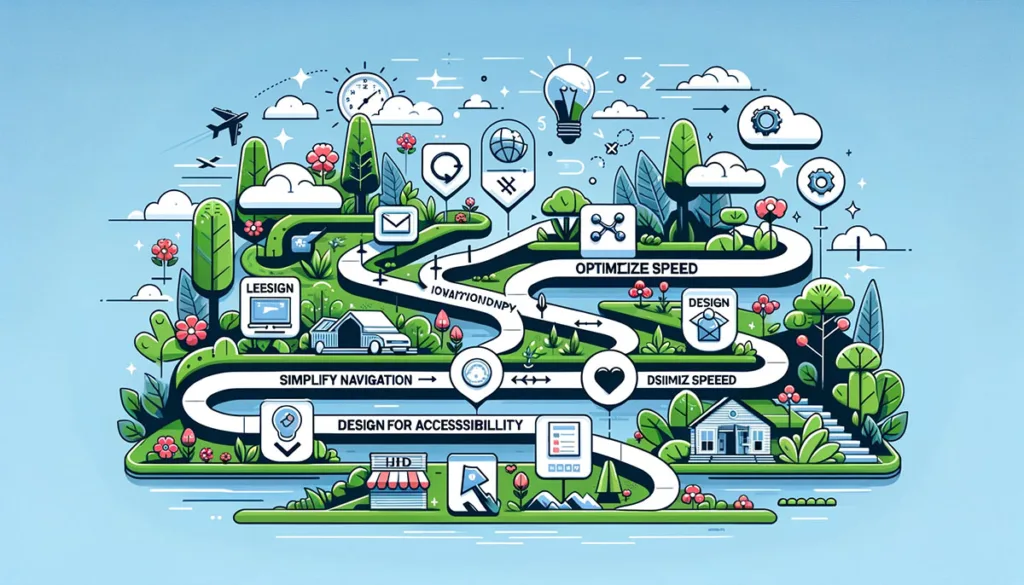How to Improve User Experience in Web Design

Introduction
Nowadays, a website’s success level is independent of its content and how it is delivered. User experience (UX) was born to be a crucial usability factor in web design that eventually affects user satisfaction, conversion rates, and long-lasting brand reputation. A proper user experience (UX) can be the reason behind an online business site that captivates and converts visitors and repels potential engagements.
Why UX Matters in Web Design
One of the critical features of UX design is anticipating and meeting the users’ needs for a site, providing them with incentives to find value, ease, and enjoyment in the site. This attention to the user surpasses a mere aesthetic purpose and captures the essence of usability, accessibility, and the journey it goes through on your website. The importance of UX to business goals is impossible. Websites with great UX design have more engaged visitors, lower bounce rates, better conversion rates, and higher client loyalty. With the clamor of the digital universe, a superb user experience will be what sets your website apart, making it a destination rather than just a stopover.
The Scope of This Guide
The main focus of this guide is to make the UI/UX spread less obscure in web design. By presenting essential components, integrating user research, and providing step-by-step procedures to solve details, we give you a comprehensive approach to choice. Our report will guide you through different areas, such as improving your website navigation, increasing your site’s speed to reduce loading times, or making the site accessible to all so that you can develop a better and more efficient online presence.
Understanding the Basics of User Experience (UX)

What is UX?
User Experience (UX) in web design concerns itself with the total impression a website or digital product provides to a user. It is not just the site’s appearance that acts; it is how it functions and feels from the user’s perspective. A good user experience guarantees users find that your services are worth using; these can be anything from ease of navigation to intuitive interfaces and exciting content that satisfies their needs and meets their expectations.
Why is UX Important?
The value of UX design is to create a delightful experience for users, which results in greater involvement and customer loyalty. A website planned with users at heart is more likely to convert visitors into customers and supporters of your brand. Furthermore, UX also handles the accessibility part, which is everyone’s right, whether standard or with a disability, to interact with your site successfully. In this competitive online environment, improving the user experience in web design is not just a plus; it is a must-have for success.
Explore “10 Best Principles of UX Design” to discover the keys to captivating and effective web design. Uncover the foundational strategies that will elevate your website and engage your users like never before.
The Role of User Research in UX Design

The main ingredient of efficient UX design is knowing your users. With a clear understanding of your audience’s behaviors, choices, or problems, achieving a beautiful website means the site’s objectives will be achieved.
Conducting User Research
User research is a targeted way of collecting data about prospective users and their needs. This will be done via diverse techniques, such as surveys, interviews, direct observations, and usability testing. A summarizer can help condense large sets of research findings into key takeaways, making it easier to interpret and apply insights effectively. The aim is to determine your users’ actual needs and anticipations, which you may not conjecture. Tools such as Google Forms or websites like UserTesting.com provide ways to gain this valuable data, which often determines strategic and even operational decision-making.
Applying Research Findings
The most significant value of user research is its practice. All insights from interacting with your base should ultimately feed your design strategy. Hence, assuming the research found difficulties skimming navigation end-elements, a redesign aimed at simplification and clarity becomes crucial. On the other hand, having a good sense of what users usually do on the site makes it possible to rank the content and functionalities based on their usefulness, thus simplifying the site and making it more user-friendly. User research is the key to eliminating the guesswork and paving the way for a user experience (UX) that captivates your audience.
Step-by-Step Guide to Improving UX in Web Design

Upscaling the user experience on your website requires a multidimensional approach. Using a deliberate approach, the different aspects of your users’ experience that can be improved will be addressed systematically. Here’s how:
1. Simplifying Navigation
Navigation is a key pillar of usability. The user should be able to find relevant information without frustration.
Tips for Effective Navigation
- Keep It Intuitive: Use common or popular terms and characters in menu items. Users must be clear about where an HTML link will direct them.
- Streamline Menus: Limit the menu items to avoid too many choices, as users may need to cope better. If the menu is well organized and not overcrowded, finding your articles and videos becomes easier.
- Consistent Layout: Keep your navigation consistent as you work on different pages. Design changes can disorient a user and leave them feeling lost.
2. Optimizing Page Speed
A slow website can make your potential customers peel off even before they begin engaging with your content.
Strategies for Speed Optimization
- Compress Images: Sites in general, large images are the main culprits that hinder speed. Oppress their size without limiting their quality through the use of compression tools.
- Minimize HTTP Requests: Every component of your site (images, stylesheets, and JavaScript) must be loaded individually via a separate HTTP request. Reduce them as much as possible through a project that streamlines design elements and merges fetches.
- Leverage Browser Caching: When caching is enabled, a returning user’s browser can access site parts stored locally on their computer. Hence, the returning visitor will experience faster loading times than the newbie.
3. Designing for Accessibility
Accessible design guarantees that all, including those who get around in wheelchairs and those with hearing problems, can use your site effectively.
Accessibility Best Practices
- Alt Text for Images: This also helps users who utilize screen readers and holds an advantage over those using a slow internet connection by explaining what they won’t be able to see in text.
- Keyboard Navigation: Make it possible for people with only a keyboard to browse the website so that people with disabilities can use it.
- Contrast and Fonts: A high contrast between text and background colors can establish good readability. Be sure to use legible fonts and allow the text size to be adjustable.
4. Enhancing Mobile Responsiveness
As more and more users use mobile devices to browse the internet, whatever website you create has to work perfectly on screens of any size.
Mobile Design Tips
- Responsive Design: According to Simpalm, a web design company in Maryland, “Provide flexible layouts and images that adjust to the size of the user’s screen. This method allows your website to be reached and used via any device.”
- Touch Targets: Establish clear and easy-to-click buttons and links. The recommended target size is 44×44 pixels, which can prevent users from tapping the incorrect link or button.
- Optimize Media: Make sure videos and images load fast and show correctly on mobile devices. This mobile optimization might include different image resolutions or video qualities for mobile users.
5. Incorporating Visual Design Elements
The aesthetic of your website’s visual design is a massive factor in UX. It does that in many ways, including catching attention, directing focus, and improving the general look.
Visual Design Considerations
- Color and Contrast: Pay attention to the color and make it more noticeable when you want people to click the call-to-action button. Ensure sufficient contrast for the text to be read in all background colors.
- Typography: Use fonts that demonstrate your brand character while being readable. Limit the number of fonts you use to maintain a consistent appearance.
- Whitespace: Whitespace helps reduce cognitive overload, resulting in the digestibility of content. Utilize inline white space to space out the elements and group related items. Thus, it will enhance readers’ comprehension and concentration.
By following the guidelines, you can undoubtedly have a website that is more agile, user-friendly, and efficient and, of course, one that users will enjoy.
Leveraging Advanced Technologies for Better UX

The digital timeline is prodigious, with new technologies reacting that are also very important to the user experience on your site. Incorporating these innovations into your project will help you build a more interactive, engaging, and immersive user experience.
AI and Machine Learning
Using artificial intelligence (AI) and machine learning, you can take your website to the next level by converting it into a highly dynamic and intelligent entity with the aptitude to learn and adapt to users’ changing needs and behaviors.
- Personalization: AI can monitor user data to offer tailored content, suggestions, and experiences, thus making the interaction more personalized, precise, and engaging.
- Predictive Search: Machine learning algorithms can identify and display the contexts in which users search, suggesting options to help them find topics faster and easier.
Chatbots for Improved Customer Service
Thanks to AI and intelligent technologies, chatbots can immediately help users with their transfers or transactions.
- 24/7 Availability: A chatbot with 24/7 availability will guarantee the customers’ continuous satisfaction and active participation.
- Personalized Interactions: Cutting-edge chatbots acquire information during each meeting to make more specialized responses.
Immersive Experiences with AR/VR
AR and VR can create magic that immerses users in a new mode of experience.
- Virtual Try-Ons: E-commerce platforms may apply AR to permit users to visualize various product options viewed in their spaces or worn on their bodies.
- Immersive Exploration: Travel and real estate portals can utilize VR to present virtual tours and let users visit destinations or place properties from anywhere they are.
Integrating those advanced technologies into the page design goes beyond UX optimization and helps with a competitive digital edge. Like our site, these utilities make it more interactive, responsive, and customized, adding life. Thus, these offer users a different experience.
Common UX Pitfalls to Avoid

Delivering a good user experience is about fine-tuning and grasping the issues that are frustrating to users and that are responsible for their discontent. Undefined
Overloading Users with Information
When information overload increases, most users get confused, sometimes so confused that they do not know what to do or choose.
- Solution: Try content hierarchy. First, tailor the information to the user’s needs, then use whitespace to emphasize the most significant elements.
Confusing Navigation
When the navigation could be more systematic and user-friendly, it could be annoying and frustrating, driving users away from the site. The result may be a poor experience and high webpage rejection rates.
- Solution: One fundamental way to ease users’ navigation on your site is to group similar items, name them clearly and concisely, and adhere to existing web rules to make navigation more predictable and familiar.
Ignoring Mobile Users
Poor mobile optimization can turn away users who follow the mobile internet trend because most people now use mobile internet.
- Solution: Build a design that adjusts to any screen size and touch interface and provides a compatible experience on any device.
These mistakes might prevent you from engaging your audience for as long as possible. However, you can eliminate them to make your site more friendly to visitors.
Measuring and Analyzing User Experience

Notably, if you intend to make the UX alterations successful, you will need to record and analyze how users interact with the website. This is the numbers game, which in turn assists in finding out what needs to be fixed and how the existing design changes are verified.
Google Analytics
Google Analytics’s advantage is its ability to provide insights into how viewers navigate and interact with your site. Remember to track metrics like bounce rate, average session duration, and page time, which are studied to determine user engagement.
Heatmaps
Heatmaps display where users click and move, showcasing how far they scroll on your site. Instruments such as the Hotjar help you understand what is getting a user’s attention and what goes unnoticed.
User Feedback
Positive reinforcement from users makes feedback worthwhile. Survey your customers, invite them to provide feedback via forms, and conduct usability tests to discover their opinions and ideas. The feedback may reveal a roadmap towards developing more user-friendly features.
Conclusion
Blooming and dynamic digital experiences should be the core of any website development strategy for a successful business to be realized. Given that you know the basic principles of UX design, do proper user research and establish the order in which you will apply the improvements, you will create a great site. Recollect that the path to improving your website user experience is ongoing and requires continuous login for outcomes that are not just for users but also exceed user expectations.
Let’s go ahead and implement the tactics discussed in this guide today and see how your site will soon become much more responsive, user-friendly, and pleasure-providing to site visitors. Dedication to UX superiority equals gratification for existing users and drawing the attention of new ones. In the long run, audience growth will contribute to your platform’s success.
